Definition
"Issue" is the most generic term for a wide array of items that require attention or resolution. Issue Management is the process of directing, controlling, and resolving issues. Examples of common issue types include:
- Incident
- Support Ticket
- Defect
- Deviation
- Requirement
- Request
- Bug
- Problem
- Trouble Ticket
- Finding
- Work Item
Disambiguation
The term issue management is a widely used piece of terminology in both the Information Technology and Public Relations fields. While there are similiarities, the differences are signficant enough that a detailed discussion need separate the two. Issue management in the field of public relations is typically synonymous with crisis management and the managing of potentially image-damaging situations. However, in the field of information technology and more generally in business, issue management refers to the continuous stream of incidents, requests, and problems that need to handled in a consistent, structured way. While issue tracking is logically only a piece of issue management, the term is often used interchangeably with issue management.
Issue Management Software
The need to deal with a large and diverse quantity of issues in a structured way lead to the emergence of enterprise issue management software. This software allows for the automation and structuring of processes for tracking, managing, and resolving issues. The three most common uses for issue management software are:
- IT Service Desk
- Bug and Defect Tracking
- IT Change Management
While the list of different items that have been previously grouped as "issues" can be quite wide-ranging in the business sense, they are all extremely similar in the way they are handled by a software program. They all require the same basic components: data capture, workflow, responsibility assignment, notifications, and reporting. Enterprise issue management software that has a strong core platform in these areas can be leveraged across an organization - allowing a consistent underlying approach across a broad spectrum of issue types.
The suitability of enterprise issue management systems to handle multiple issue types also allows it be extended to parts of the organization that would not typically have enough volume to justify the use of sophisticated software. Once deployed for higher volume functions like service desk and IT change management, the marginal cost of extending the system to keep track of issues in other functions or projects is usually very minimal.
Enterprise Issue Management - Not Just for IT
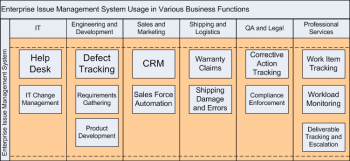
Shipping and Logistics
Shipping errors, damaged goods, warranty claims, and product returns are an unfortunate but necessary part of most business operations. If the volume of these issues is large enough a company may have specialized information systems dedicated to these functions. For many organizations and business lines, these functions do not merit a dedicated system and end up being managed on an ad hoc basis through email or spreadsheets. An enterprise issue management system can provide much needed structure, visibility, and accountability to these functions. As a byproduct of leveraging an issue management system to facilitate management of shipping and logistics issues – an organization ends up with an aggregated collection of these issues in a database, where they are easily accessible for data mining and root cause analysis.
Sales and Marketing
Most discussions of software for the Sales and Marketing function begin with the idea of Customer Relationship Management (CRM). Each interaction a customer or potential customer has with an organization is important to the overall relationship; however, the data on those interactions are often highly fragmented throughout an organization. Enterprise issue management software provides a straightforward way to pull all that information together across an organization. Sales Force Automation (lead tracking and contacting) is more powerful when connected to Customer Support data and vice versa. A widely utilized issue management system could potentially pull even more complimentary data together as additional departments make use of the system. CRM software is not inexpensive, so the ability to leverage issue management software for this purpose in addition to other functions can make good financial sense.
Quality Assurance and Legal
Compliance and auditing is a fact of life in highly regulated industries and with the appearance of Sarbanes-Oxley and new data privacy requirements, the realities and burden of compliance has been extended to more and more organizations. Compliance and audit findings are often issued in narrative form, a great format for summarization, but extremely lacking in its ability to initiate and track corrective actions and follow-up items. Enterprise issue management systems can provide essential pieces of functionality to the Quality Assurance and Legal functions through its abilities to provide tracking, responsibility assignment, transparency, and automated escalation. One could also argue that enterprise issue management systems, by virtue of their enforcement of procedures and processes, help prevent non-compliance and future QA issues.
Professional Services
Professional services are all about deliverables and efficient project management. As complexity and volume grow, maintaining control and visibility becomes more challenging. Tracking work items and responsibility is a critical component of an active professional services group. Enterprise issue management software can be a very effective tool for managing professional services. Work order tracking, work-item backlog, and escalation capabilities are standard components of an issue management system and can be leveraged to make sure commitments do not fall through the cracks. Roll-up reporting also allows management visibility into the details as well as the big picture, which might also include data from customer support, quality assurance, and sales.
Business Process Management
Business Process Management(BPM) is practice closely aligned issue management. BPM generally refers to the modeling, refining, and optimization of business processes. Effective issue management requires that the optimized business processes be faithfully reproduced as part of the issue workflow. Enterprise issue management software brings the processes to life, enforcing requirements, handling decision points, and capturing metrics which can be further leveraged to feed a cycle of continuous improvement.
Best Practices
Designing Workflows
Please see the section devoted specifically to workflow and workflow examples.
Designing Forms
The primary point of data entry and data capture in an issue management process is the form. This time-tested, stalwart labors on in paper-based systems as well as in modern issue management software. Here are several tips for designing effective forms:
- Put only as many fields on a form as is needed - research shows that the more fields a form has, the less it will be used. Someone must champion economy in a team-based setting. Forms created by committee are pre-disposed to field bloat.
- Increasing the number of required fields on a form will typically increase the quality of the forms submitted but will decrease the volume submitted - optimize the amount of fields based on your goals.
- Forms should be specific to the purpose. In paper-based systems there was a legitimate reason to use the same bloated form for multiple purposes - to save paper. In a software system, this few benefits and only serves to clutter the form.
- Data should only be entered once. One of the crucial advantages of issue management systems and the databases that power them, is the ability to eliminate the need for multiple data entry.
- Autofill known data where possible. For instance, user contact information is usually tied to a user's login - a well designed form will prepopulate this information.
- Minimize the amount of data captured in large free-text fields. This data is less useful for querying and data mining.
Describing Issues
To ensure quick resolution to issues that are found, it is important to provide as much information as possible in the initial issue report. Below are some tips for creating a solid issue report:
- Create a descriptive title
- Create detailed steps to reproduce
- Attach screenshots
Additional Best Practice Resources
- Open ITIL Wiki - ITIL (the IT Infrastructure Library ) is the most widely accepted approach to IT service management in the world. This wiki is an insightful resource on ITIL practices, which are largely obscured behind paid publications.
- Nine Issue Management Best Practice Indicators (IMC) - While principally aimed at the public relations profession, this resource is very applicable to all issue identification, issue tracking, and issue resolution scenarios. Selected best practices include:
- There is an established mechanism to identify current and future issues through environmental scanning /issue analysis.
- The organization has adopted a formal process to assign and manage issues.
- The Path to Successful Defect Tracking - Things to consider when developing a software defect tracking process and/or selecting a defect tracking system.
Workflow Examples
In issue management and the closely related discipline of business process management (BPM), the core element that brings order to chaos is the workflow. Most processes have a fairly standard workflow, whether it has been formalized into a computer program or not. Sketching the desired workflow out, on paper, or in a program such as Visio, is one of the invaluable first steps in creating a repeatable, structured process. The following examples provide a starting point for several common issue management processes.
Tips for creating great workflows:
- "Make everything as simple as possible, but no simpler." - Albert Einstein
- Steps should maintain a logically consistent level of activity and complexity. If a process has 5 very precise steps, it should not also have a vague step that could reasonably be broken down into precise steps.
- Avoid unnecessary steps. The prime example of this is the "Implementing" step that often turns up in defect tracking workflows. For the vast majority of issues, this simply adds an additional step that must be transitioned through in order to be closed. In most cases, "not started" and "closed" are adequate.
A couple notes on the workflow diagrams that follow:
- The starting state of the workflow is in green.
- The intermediate states of the workflow are in blue.
- The final state is in red.
- The transitions between states look relatively shallow in an image, but in a functioning issue management system, transitions often trigger many activities in addition to just changing the state (i.e. sending notifications to affected parties, creating separate processes with their own workflows, or even executing complex scripts). In the examples here, gear icons on the transitions indicate places where these additional actions occur.
Sample Simple Issue Workflow
These two workflows cover the fundamental elements that would be in place for almost any simple issue. The first workflow is a little more deliberate in that it covers each of the base states in a logical progression. If rigidly enforcing a process is the aim, this type of workflow is needed. In the second workflow, a critical difference is the direct connection between an entry state and a completed exit state. For simple issues, having the ability to quickly jump to completion is a key reduction in friction for the process, as it eliminates the need to transition through intermediate states that really provide no value. This particular process is implemented such that the intermediate states can be used if necessary, while also retaining the flexibility to complete in one step.
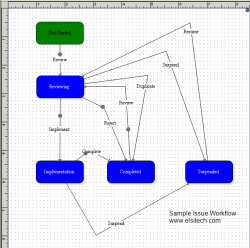
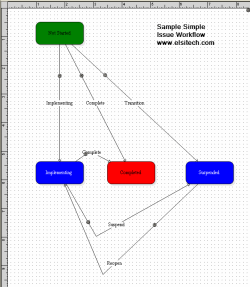
Sample Comphrensive Software Defect Workflow
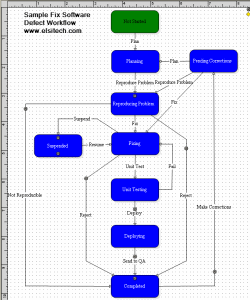
This workflow for resolving a software defect contains many states and is rigid in the linear way it moves from entry to exit. It contains most of the states one would expect to see in a professional software environment, from an initial reproduction of the defect, through the fix itself, testing the fix, and ultimately deploying the fix. The workflow also allows flexibility to market the defect as non-reproducable (removing it from the development queue), suspending work on the issue, and reopening the issue once it was been closed. While every organization has its own unique processes, the workflow represented here provides a reference for the typical states of a "fix software defect workflow."
Sample Help Desk Workflow
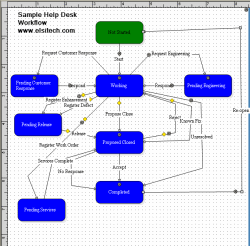
Help desk or service desk workflows are often highly customized and can vary tremendously based on an organizations business needs and support hierarchy. The diagram shown here assumes a single tier of help desk technician, though it is not unusual to have multiple tiers and escalation levels in a support process. One of the unique aspects of the support process, is how many different groups support touches. In this workflow there are options to rout the issue to engineering for a technical assessment, or to register it as an enhancement or defect for development to resolve, or even to route the ticket to a professional services group for fee-based activity.
If it were routed to one of these other groups, a work item with it's own workflow would be generated, which could be processed independently from the initial support ticket, while maintaining the integrity of the original ticket and workflow. A key feature of enterprise issue management systems is the ability to orchestrate complicated processes across business groups.
Additional Resources and Organizations
- Official ITIL Website - ITIL® (the IT Infrastructure Library ® ) is the most widely accepted approach to IT service management in the world. ITIL provides a cohesive set of best practice, drawn from the public and private sectors internationally.
- ITIL Wikipedia Article
- IT Service Management Forum - The knowledge network for IT Service Management, includes network of professionals, forums, and access to a calendar of itSMF conferences worldwide.
- PRINCE2 Project Management Methodology - PRINCE is a generic, tailorable, simple to follow project management method. It covers how to organise, manage and control projects. Issue management and tracking usually exists in the context of a project, so it is critical to design issue tracking processes with an awareness of project management best practices.
- PMI (Project Management Institute) - With more than 260,000 members in more than 171 countries, PMI is the leading membership association for the project management profession.
- Issue Management Council - The Issue Management Council (IMC) is the professional membership organization for people whose work is managing issues and those who wish to advance the discipline. It is primarily focused on the public relations side of issue management as opposed to the IT side.
Research
- Increasing Software Engineering Efficiency Through Defect Tracking Integration - International Conference on Software Engineering Advances
- Complete Defect Management Process - Mosaic Consulting; includes additional print academic references.
- Software Testing Research and Articles - Professor Cem Kaner at Florida Institute of Technology.